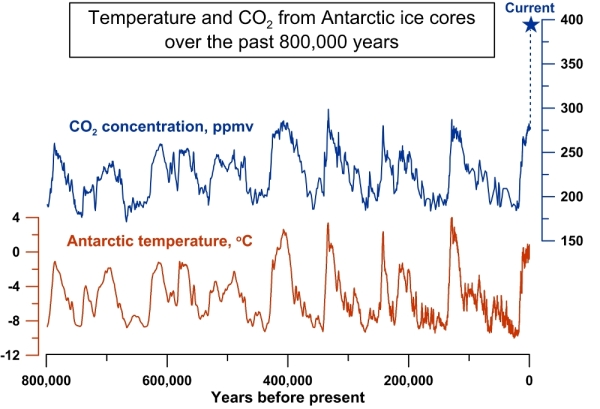How ice ages come and go.
Some people wonder if the current climate change has "natural causes".
They sometimes refer to the changes during the 'Ice Age' and think the current events must be natural as well.
Scientists say that is not the case.
The current situation is different.
The things that caused the changes in Ice Age are not exactly the same.
The graph shows that carbon dioxide in the air has increased and decreased over hundreds of thousands of years.
The recent increase in carbon dioxide is much bigger and faster than the natural changes.

The low readings match with times called 'glacial stages'.
During glacial stages, ice covered large areas of the Earth.
The most recent glacial stage occurred between 115,000 and 11,500 years ago.
The peaks in the graph show times when carbon dioxide was high.
Those times are called 'interglacial stages'.
Glacial and interglacial stages are linked to regular patterns in the movements of the Earth.

They sometimes refer to the changes during the 'Ice Age' and think the current events must be natural as well.
Scientists say that is not the case.
The current situation is different.
The things that caused the changes in Ice Age are not exactly the same.
The graph shows that carbon dioxide in the air has increased and decreased over hundreds of thousands of years.
The recent increase in carbon dioxide is much bigger and faster than the natural changes.

The low readings match with times called 'glacial stages'.
During glacial stages, ice covered large areas of the Earth.
The most recent glacial stage occurred between 115,000 and 11,500 years ago.
The peaks in the graph show times when carbon dioxide was high.
Those times are called 'interglacial stages'.
Glacial and interglacial stages are linked to regular patterns in the movements of the Earth.

The Earth's movements cause warming or cooling.
This changes the amount of carbon dioxide that can dissolve in the oceans.
As the Earth warms, more carbon dioxide leaves the oceans.
The extra gas in the air boosts the warming effect.
The Milankovitch Cycles now are tending to cool the Earth.
So the current warming is not part of natural processes.

Law Dome is a site in Antarctica where scientists have drilled into the ice.
This changes the amount of carbon dioxide that can dissolve in the oceans.
As the Earth warms, more carbon dioxide leaves the oceans.
The extra gas in the air boosts the warming effect.
The Milankovitch Cycles now are tending to cool the Earth.
So the current warming is not part of natural processes.

Law Dome is a site in Antarctica where scientists have drilled into the ice.
Global temperatures are only just beginning to respond to the recent big increase in carbon dioxide.
The carbon dioxide has come mainly from burning fossil fuels.
The carbon dioxide has come mainly from burning fossil fuels.